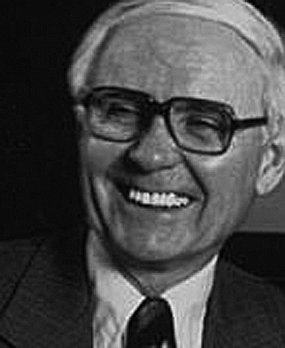How has he transformed the scene?
In 1986—the year of his retirement after nearly 30 years as president and CEO of Minneapolis-based Control Data Corporation—William Norris was awarded the National Medal of Technology by President Ronald Reagan. In presenting the award, President Reagan recognized Norris for his “substantial contributions to the development of digital computer technology, leading to the founding of a successful computer and computer services company, and for his innovative application of computers to societal needs, as well as his initiation of cooperative efforts which promise to maintain U.S competitiveness in microelectronics and computer technology.”
“Sometimes you just have to beat hell out of a problem in order to get on top of it.”
William Norris, (in) 1986 interview conducted by Arthur Norberg, Minneapolis
Minnesotans might have summed up Norris’ contributions from a more personal perspective. In his decades of leadership at Control Data, Norris made sure that Minnesota—and Minnesotans—came along for the rise. CDC’s success translated locally to opportunities for people of all educational levels to find lifetime careers in the computer industry. It fostered growth in the industry and the economy through creation of more than 80 new technology based CDC spin-off companies; and it gave Minnesota a reputation for high-tech prowess that would serve the state well for many years to come.
“Norris not only marched to a different drum, he created the company that built the drum—and pounded out the beat for nearly three decades.”
Peter Behr (in) The Washington Post, 1986
Norris dared to re-define “business as usual” to directly address social needs—not through philanthropy alone, but through profitable enterprise. Under his watch, CDC established plants in impoverished inner-city neighborhoods and remote rural settings to provide much-needed jobs and boost local economies; he supported programs to put cutting-edge technology at the disposal of small family farms; he created business development centers to serve as incubators for innovation and growth, and made inroads for technical education into elementary schools, universities, even prisons. Norris took the long view in an often shortsighted world.
During his tenure as CEO of Control Data, Norris was a major advocate for computer-aided instruction in the schools, known as the PLATO project. The idea was right, if not sufficiently in sync with the market and the times.
On the national scene, Norris was active in policy-making to create a favorable climate for growth of the high-tech industry and related research. He was instrumental in drafting and passage of the National Cooperative Research Act of 1984 and the Technology Transfer Act of 1986, which led to the creation of the Small Business Innovative Research Program.
William Norris traveled a circuitous route to his leadership role in the worldwide computer industry. He earned an electrical engineering degree from the University of Nebraska in 1932, in his words “graduating right at the bottom of the Great Depression.” With engineering positions scarce to non-existent, Norris worked stints with Roosevelt’s Civilian Conservation Corps and Westinghouse (a marketing position which paid better than the engineering position he would have preferred). Within weeks after Pearl Harbor, Norris took a commission in the Navy’s cryptologic agency, where he would meet many of the men who would later form his team of business partners, leading technical innovators, and fellow entrepreneurs.
Their first post-war foray into a commercial enterprise was the founding of Engineering Research Associates (ERA) in St. Paul, MN. When ERA merged with Remington Rand/Sperry Rand in 1951, Norris stayed on to lead the firm’s Univac Division. But by 1957, Norris was ready for a new beginning. He stepped into a role that he would hold for the next three decades—founding president and CEO of Minneapolis-based Control Data Corporation (CDC). Norris and his team would lead CDC into the history books by building computers that were the fastest in the world.
In 1964, Control Data introduced the first commercial supercomputer; twenty years later, the corporation posted a peak of $5 billion in annual revenues and had a global workforce of 60,000.
In the years after Norris’ retirement, Control Data would split and its assets would be merged and morphed into new enterprises (most notably, Ceridian Corporation). As personal computers were gaining importance in the market, the name Control Data was becoming a part of business history.
If Control Data lost some momentum in the 1980s, Norris did not. He chaired the nonprofit William C. Norris Institute from 1988 to 2000, continuing in his efforts to support the growth of technology-based, socially beneficial, visionary companies in Minnesota. The Institute focused on projects such as improvement of K-12 education through use of technology, technical training in Russia, and support for technology-based initiatives of Minnesota entrepreneurs.
William Norris passed away at the age of 95. The William C. Norris Institute, based at the University of St. Thomas, carries on his legacy.

